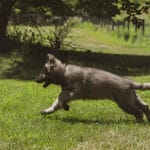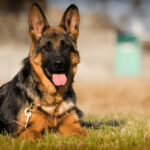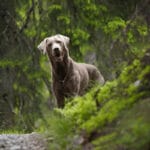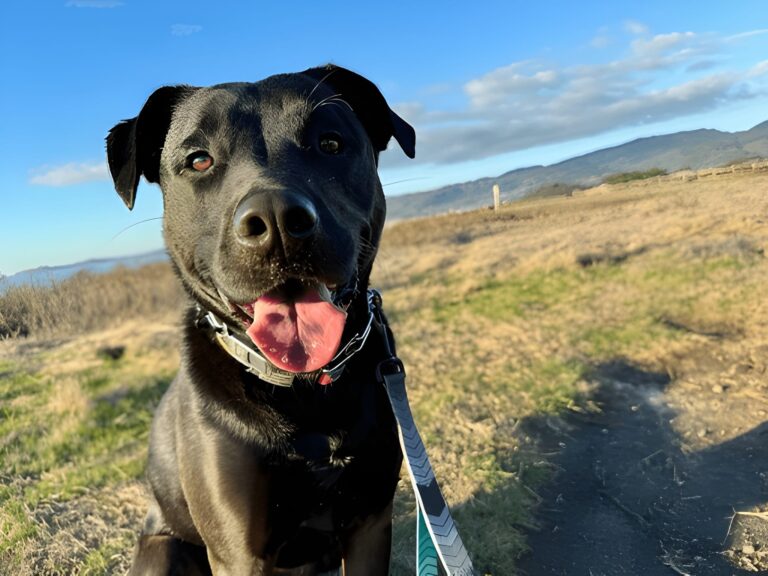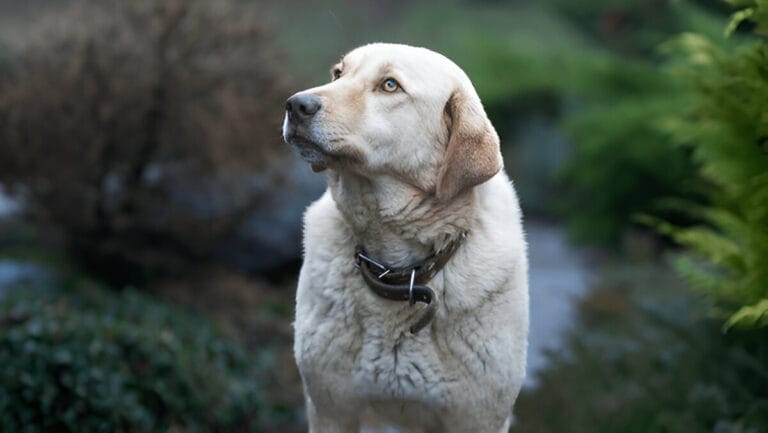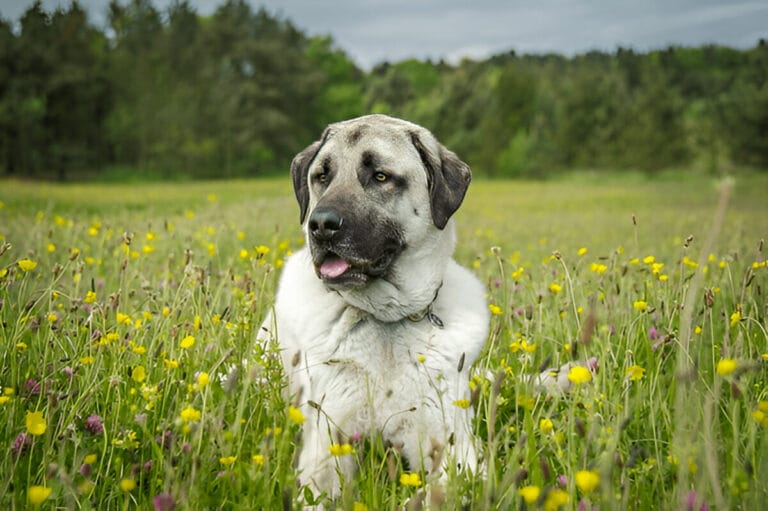Meet the Stunning Black German Shepherd
Black German Shepherds are extremely rare and highly sought after variations of the 2nd most popular dog in the United States according to the AKC. What do you picture when you hear someone talking about a German Shepherd? You might picture a fearless police dog in action or recall the legendary Rin-Tin-Tin
who earned his place on Hollywood’s Walk of Fame. But almost everyone tends to see them as Sable colored, though did you know that these gorgeous dogs can have a completely black appearance?
Many folks don’t realize that the American Kennel Club’s actually accepts black German Shepherds for registration, treating them exactly like GSDs of any other color according to their official breed standards. Although their dark coloring might seem to add an enigmatic quality, their character traits are well-established – these dogs are loving, bright, and deeply faithful to their families while maintaining strong guardian instincts and bold courage.
Currently, some argue that these genes are defective as a result of mix breeding, but this couldn’t be further from the truth. This is actually a simple case of gene combinations making this appearance, like Silver Labradors.
Though GSDs with fully black coats are still pretty much rarer than the usual single coat pattern with tan, they’ve gained popularity in recent years among pet lovers who want to add something more unique and trendy to their family.
Usually, these beautiful shepherds are large dogs who stand up to 26 inches tall and can adapt to families and households as long as their needs are met – they get along well with children and make exceptionally beautiful companions.
If you’re considering adding this loyal breed to your home, We’ll help you gain in-depth insight into everything about them, covering his history, temperament, care, and trainability.
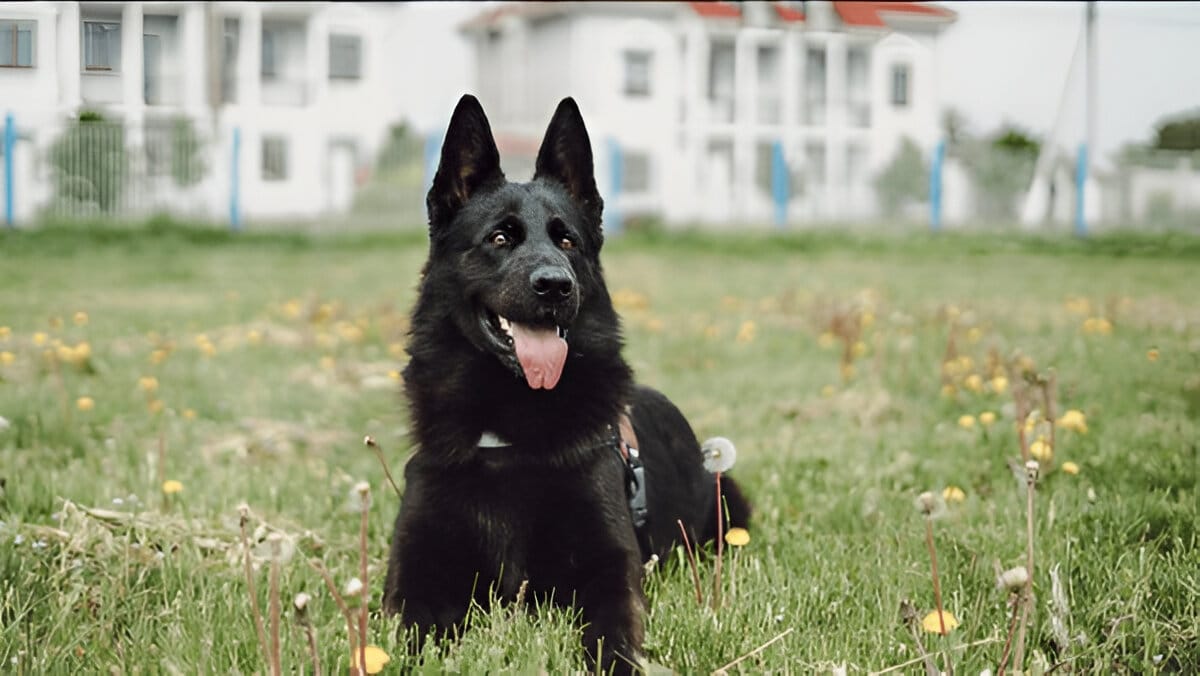
Photo credit: Shutterstock by lisovyleo
History: Origins of the German Shepherd
By 1859, generalized herding dogs across Europe had split themselves into a few different distinctive breeds, including the German Shepherd. During the 1850s, an attempt to standardize the dog and promote traits that encouraged better sheep herding – like speed, strength, endurance, and intelligence – was underway.
However, varieties still existed from place to place, with slight breeding differences that led to slightly different shepherds. As the industrial age progressed, the demand for herding dogs dropped significantly alongside declining predator numbers, leading to fewer people owning these dogs, and those who still had them weren’t need tons of them.
Luckily, at this point people were already recognizing their ability beyond herding, and these previous native dogs of Germany were considered perfect for working roles in many capacities due to their exceptional qualities.
The first official German Shepherd didn’t appear until 1899, when a dog named Horand von Grafrath was purchased by a man called Von Stephanitz, who then founded the Society for Dogs. Honrand became the main poster dog for the breed, and from this single animal, the breed standard grew.
In just a few generations, he became one of the most populous studs in the world and fathered countless puppies – nearly all GSDs today are descended from him. There was quite a bit of inbreeding that occurred to produce the dogs we know today, and for instance, Honrad’s offspring were often bred together.
Black German Shepherds existed to some extent back then since they were produced naturally, however, dogs that did not carry the completely black gene were more common in the past, and solid black ones were likely culled at birth as a supposed defect.
Today, we’re seeing a reoccurrence of interest in these striking dogs, which is one reason you picture GSDs working in police and military roles – because they excel at this work. As their name suggests, they were bred to herd and protect livestock, and after several were brought to America, they have been highly favored ever since,ranked as the second most popular breed according to the AKC’s preferred breed rankings.
While the ambiguous roots of many breeds isn’t uncommon, that’s not the case with the shepherd – his creation actually began thanks to a cavalry officer named Max von Stephanitz in the late 19th century, who was inspired by his love for these dogs and made increasing efforts with the goal to develop an ideal working dog.
With assistance from various breeders, he spent years selectively creating the predecessors of the dogs we’ve known and loved for generations. He founded the formal German Shepherd Dog organization and dedicated the following years to developing and perfecting the breed, which rapidly became beloved worldwide.
By the 1990s, virtually every dog lover had heard of them or wanted one of these lovable companions, and they have since gone on to become a leading choice – there’s no doubt their unrivaled loyalty and bravery contributed to this success. The breed was officially recognized by the American Kennel Club (AKC) in 1908, making them among the earliest breeds accepted into the registry.
Breed Overview: The Black GSD
Like we mentioned before, despite common misconceptions, the Black German Shepherd is not a separate breed or a mixed breed dog. In reality, they’re simply a single-color variation that possesses all the same wonderful qualities and features that make traditional German Shepherds so endearing.
So if you’ve ever successfully owned a traditional German Shepherd, this variation will be perfect for you. Sought after for their unique coats and protective nature, the GSD makes an ideal guard dog if you choose to add one to your family – you’ll certainly be impressed with how easy he is to train. As historic working dogs, they’re known for their exceptional intelligence and trainability, making them responsive to consistent guidance and commands.
Because these dogs are so rare, they cost a lot more than the traditional Sable variations you typically see. For example, while a standard puppy may cost anywhere from $300 to $700 depending on the breeder, a black one will likely run around $2000 or more.
Breeding litters of black German Shepherds is difficult and usually requires two black parents, though sometimes a tan colored dog could produce black puppies under the right genetic conditions.
When shopping around, it’s absolutely important to make sure you’re getting a healthy dog from a reputable source, or consider the option to adopt one from a local shelter or rescue organization where you might find these remarkable dogs at a more affordable price.
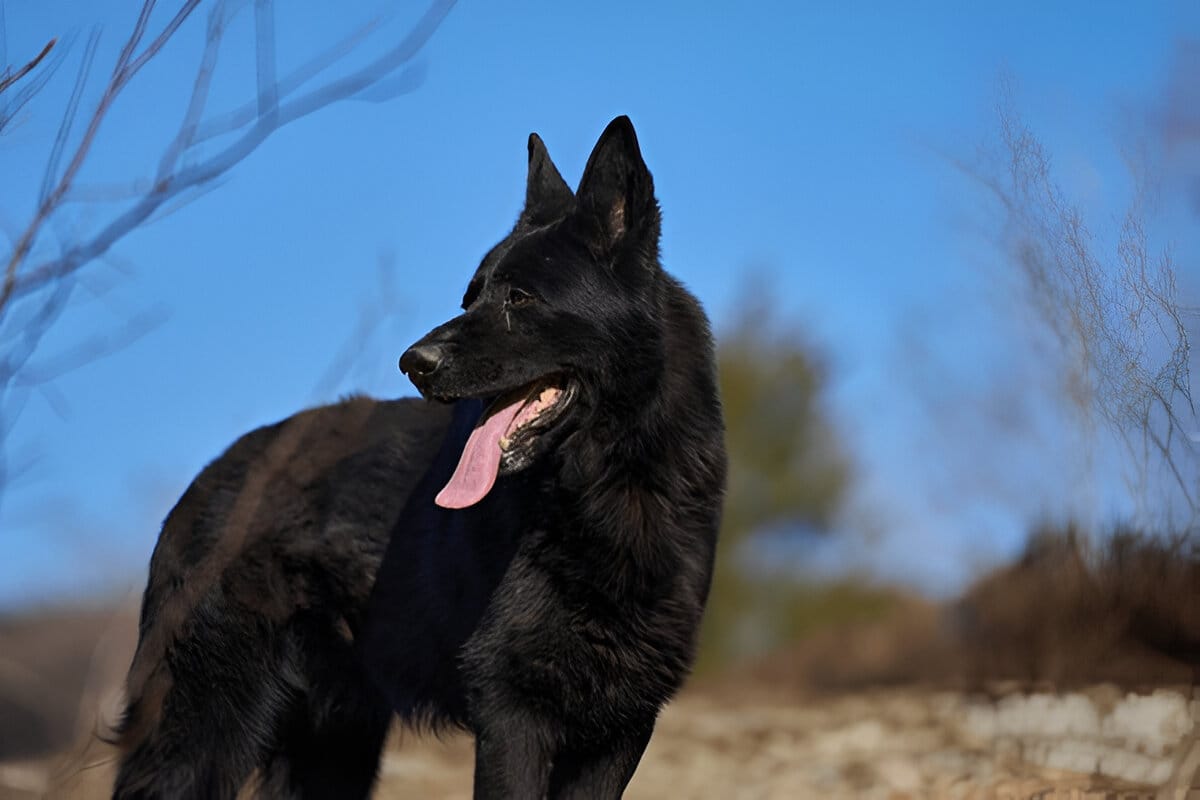
Photo credit: Shutterstock by LightTheurgist
Temperament & Appearance: What to Expect from Your Black German Shepherd
Temperament
Like most dogs, the Black German Shepherd will thrive with early and frequent socialization around pets and people of all ages. While they are naturally pretty friendly and loving, they may warm slowly to strangers initially, but once trust is established, they become incredibly loyal and devoted to every member of their families.
Working breeds love to have a job, and the GSD is no exception – as a house pet, your dog will likely make up his own duties like protecting and guarding the family.
Ever watchful with those adorably alert ears, they’ll let you know if anything is going on in or around your home, making them excellent natural guardians. In fact, he won’t be happy when you’re out of sight for too long and is best suited for families that can keep someone home at least part of the day since they can suffer from separation anxiety when left alone for extended periods.
This loneliness can lead to excessive barking and other destructive behaviors that nobody wants to deal with. It would also help if you’ve owned large breeds previously and you’re not a first time dog parent, since all Shepherds are powerful dogs with great exercise requirements that you need to meet to avoid them developing negative habits.
They do best with owners who understand and can accommodate their specific needs effectively. Think about any black shepherd and the first word that probably comes to mind is fearless – and this couldn’t be more true about these remarkable dogs. These are exceptionally brave and confident animals that excel at protection work and are often used as police and military working dogs.
However, shepherds aren’t all work and no fun – they play enthusiastically and appreciate having a playmate, particularly when they can enjoy interactive games where they spend one-on-one time with their owners.
They’re highly adaptable, though these active pups need owners who can match their high energy level and may struggle when their exercise needs aren’t met, so they’re perfect for people who want them to be active companions.
Appearance
Black German Shepherds possess identical physical traits to other GSDs – they have the same body structure and reach the same dimensions as any other purebred in the line. Males usually weigh between 65 to 90 pounds, while females are typically 50 to 70 pounds, making them considered medium-to-large dogs, so you should consider whether you have adequate space before adopting one.
Many people don’t realize just how large these dogs become and adopt them only to begin to regret their decision later on when they outgrow their living situation. Their height is around 22-25 inches tall, and this measurement is correct for both genders, though males don’t tend to differ much in height but are generally bulkier than females.
Most traditional German Shepherds have at least a little bit of tan markings, however, there’s nothing about the coat that’s generally different besides the unique coloration.
The double-coat helps them stay clean and warm throughout various weather conditions. As working canines, they’re built for work and it shows in their athletic frame, and this color is fully accepted by the AKC as a standard variation. It is also not a result of crossbreeding as some misinformation may state – instead, it’s simply a rare genetic outcome where very few dogs end up with this striking coloring.
This trait has been around for a long time and is sometimes encouraged through selective breeding by dedicated breeders. While the gene for solid black coloring is recessive, some parts of bloodlines actually carry this trait, and breeders who understand genetics can work with dominant genes carefully.
When using selective breeding techniques, breeders do need to be careful not to wipe out other colors within the breed.
These dogs always have dark-colored eyes – blue eyes don’t exist in this variation, as that would be a sign the dog has other breeds in his pedigree, such as Huskies. Other than the coat color, the body looks exactly like their tan cousins – all have the signature pointed ears that are typically erect, though floppy ears in adults can be seen occasionally.
What Size Is a Black German Shepherd?
A black German Shepherd is a substantial canine with striking proportions – male dogs reach 24 to 26 inches in height at the shoulder and typically weigh 65 to 90 pounds, whereas females are somewhat more compact, measuring 22 to 24 inches tall and weighing between 50 to 70 pounds. The exact size of your dog will ultimately depend on his genetics and lifestyle factors like diet, making proper nutrition crucial for healthy development.
Nevertheless, it’s crucial to avoid overfeeding your German Shepherd to maintain an ideal weight, as these dogs tend toward weight gain which can worsen existing health conditions or trigger new issues like hip dysplasia, gastric torsion, and diabetes that can seriously affect their well-being and lifespan.
How Black German Shepherds Inherit Their Stunning Coat?
For a German Shepherd to have a solid black coat, specific genetic factors must align—here’s how it works: the dominant black gene (K-locus) suppresses lighter colors, ensuring no tan or red appears in their fur.
1. Recessive Gene Inheritance:
The gene responsible for black coat coloring in German Shepherds works differently than most people expect. Having worked with these magnificent dogs for over a decade, I’ve witnessed countless breeding’s where owners were surprised by the outcomes.
This recessive gene operates under strict rules – both parents must carry this specific genetic marker in their offspring to have any chance of being all-black. Even when two carriers are bred together, not all puppies will display the solid black coloring.
Observing multiple litters, typically only about 25% of puppies in a litter will be completely black. Some may inherit the more common standard colors like black and tan or sable, depending on the complex genetic mix that determines coat patterns.
What makes this particularly fascinating is that two seemingly standard-colored parents can produce black puppies if they both carry the hidden recessive gene, which explains why these striking dogs sometimes appear unexpectedly in breeding programs.
2. Two Breeding Possibilities:
Through my years of working with German Shepherd breeding programs, I’ve observed two primary pathways that produce black puppies. Both parents are full-blooded Black German Shepherds creates the most predictable outcome – this guarantees that every single puppy in the litter will consist exclusively of black coats because there are simply no alternative color genes available in their genetic makeup.
However, the second scenario involves parents who appear to have standard coloring but carry the hidden recessive black coat gene. In this case, some puppies may be born with the distinctive solid black coloring while others have typical color patterns including black and tan or sable variations.
What fascinates me most is how unpredictable the second method can be – I’ve seen litters where only one or two puppies display the solid black trait, making them incredibly special to their new families.
The genetic lottery aspect keeps even experienced breeders on their toes, as you never know exactly what combination of colors will emerge until the puppies arrive.
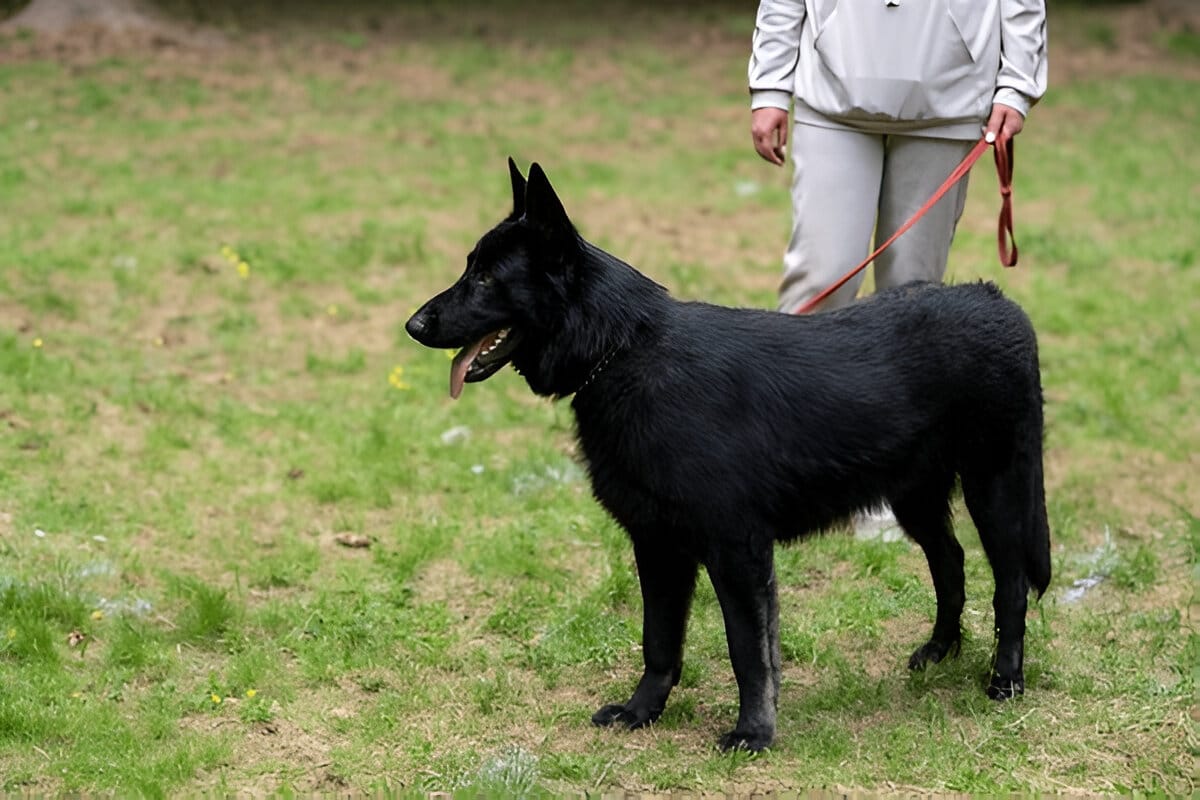
Photo credit: Shutterstock by Artsiom P
What Makes This Breed Unique?
Black German Shepherds possess all the exceptional traits that make this breed so beloved, extending far beyond their mesmerizing appearance. This breed that has captured the hearts of dog lovers around the globe.
They are highly intelligent and quick to learn, making them incredibly responsive to training – I’ve personally witnessed how these dogs can master complex commands within just a few sessions. These Loyal companions who form deep bonds with their families display an unwavering devotion that goes far beyond simple obedience.
Hardworking and versatile, they excel in demanding roles like search-and-rescue, police work, and as service animals, where their sharp instincts and reliable temperament prove invaluable. Physically striking, their sleek black coat sets them apart from their traditional counterparts and adds an air of elegance that commands attention wherever they go.
Caring for Your Black GSD
The black German shepherd stands out as an exceptional choice that’s surprisingly well-suited for first-time owners, provided you are willing to put in the time and effort required to meet his needs. You must be prepared to match their naturally high energy level through consistent engagement.
You should take him to the vet for regular health checkups and ensure you exercise him daily. Feed your companion a healthy diet – and remember, that means no table scraps regardless of those pleading eyes. You’ll also need to establish a consistent grooming routine to keep that gorgeous coat looking pristine.
As long as you embrace these responsibilities with dedication, you can discover that these intelligent, loyal companions reward your efforts with unwavering devotion.
Grooming Your German Shepherd
The grooming requirements for your black German Shepherd will primarily be determined by their specific coat variety. Medium-coated dogs will need only brushing two or three times a week to maintain their appearance. This helps prevent tangles as well as removes dirt and dust from the dog’s fur effectively.
Long coats must be combed through at least once each day to avoid mats formation. Otherwise, they become needlessly tangled and may require assistance from a professional groomer. Because of their double layer structure, all types shed profusely throughout the year.
Do not adopt one unless you can deal with a lot of extra hair around your home. Even if you brush daily, they still leave fur everywhere in your living space.
Twice each year, these dogs blow their undercoat, which typically means that the shedding level will increase substantially. Usually this occurs in spring and fall, but it can depend on your local climate conditions. Shedding is also tied to hormones, not just weather patterns.
As a result, these dogs experience seasonal coat shedding regardless of whether they reside in climates with distinct seasonal changes.
There is little you can do to reduce the overall amount of fur they shed. However, anti-shedding shampoos, a high-quality diet, and a velocity dryer can help manage the situation. German Shepherds typically experience intense shedding periods two times annually.
During this time, brushing becomes a daily process to stay along with the increased fur production. But during the rest of the year, your Black companion should require only good maintenance or weekly attention. For cleanliness maintenance, focus on removing dirt as it occurs and bathe your German Shepherd thoroughly every two to three months.
Bathing him too much strips his skin of natural oils and dries them out unnecessarily. Ears should be checked regularly, more so if your dog swims often. Since their ears stand erect on their heads instead of flopping over like most other breeds, their ears tend to get dirtier than others.
If there’s no worries about infection, simply wipe them with a damp cloth for maintenance. And of course, grooming can be stressful for some dogs, so start by gently bathing your puppy as soon as you bring them home so they grow accustomed to accept it as a normal part of life rather than something to be feared.
Common Health Issues
Black German Shepherds are prone to certain health conditions that affect a few different body systems. These issues are the same as those found in black-and-tan varieties, so it isn’t surprising that these dogs aren’t completely more likely to develop certain issues compared to their traditionally colored counterparts.
Many of these dogs have hip and elbow dysplasia, a concerning condition that affects joint function. This disease occurs when the ball and socket of the joint do not line up correctly, leading to excess wear-and-tear over time.
Eventually this will cause arthritis-like symptoms, but at a much earlier age than traditional arthritis typically shows in most dogs. Usually, the damage begins during puppyhood while the dog is growing, though they may not show visible signs until years later when the deterioration becomes severe.
There are several things pet owners can do to reduce the chance of dysplasia in their Shepherd. Overfeeding has been proven to cause a dog’s joints to start developing at an unusual rate due to increased calorie intake during crucial growth periods.
Over exercising your puppy can also have a dramatic effect on joint development, which is why we don’t recommend forced exercise, especially for puppies under 18 months. These dogs are frequently affected by degenerative spinal stenosis as well.
For instance, one study found that up to 45 percent of adult German Shepherds had this condition as adults. However, the study had a notably small sample size and may not be entirely accurate in representing the broader population.
On a good note, black German Shepherds actually experience less frequent ear infections than other breeds with similar ear structures. They possess overactive cerumen-producing glands which help prevent bacteria from setting up residence in their ears.
Degenerative myelopathy affects this breed often enough that they’re considered predisposed. A DNA test can check for predisposition, though it’s very expensive and many breeders don’t perform it before breeding or well after puppies are born.
Once this testing is used regularly, it becomes easy to remove this condition from the breed through selective breeding practices. You should simply never breed an affected dog to prevent passing on the gene. Von Willebrand disease occurs at a higher level in German Shepherds than the normal population. It is genetically predisposition and can cause bleeding disorders.
Exocrine pancreatic insufficiency can be treated with medication and supplements when caught early. For most genetic conditions, consistent testing and keeping track of pedigrees remains important for eliminating these issues from future generations.
Conclusion
If you’re looking for a loyal and striking companion, the Black German Shepherd makes an exceptional choice. With its sweet disposition and unique black coat, this breed quickly becomes a favorite—especially in families that appreciate both beauty and brains. I’ve seen firsthand how these dogs thrive when given the right balance of exercise and affection.
Provide exercise and attention, and this canine will reward you with unshakable loyalty. Their sharp minds and guardian instincts, combined with that stunning dark coat, create a truly memorable companion.



